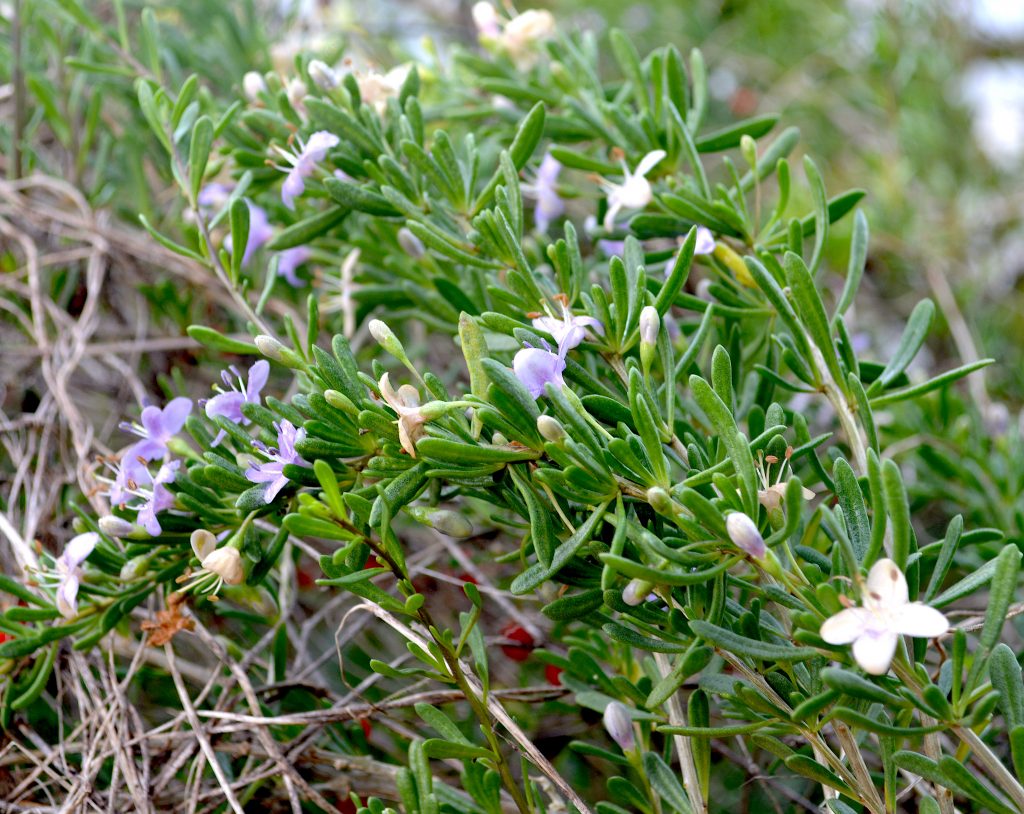
Are your Goji berries ripe? It depends where you are. Photo by Green Deane
What difference can 172.4 miles make? Two weekends ago our local Goji berry was ripe and for the picking in New Smyrna Beach. Last weekend 172.4 miles to the southwest in Ft. Desoto the species was still blossoming, had a few unripe berries and one ripe berry. You can read about the fruit here and watch video here.
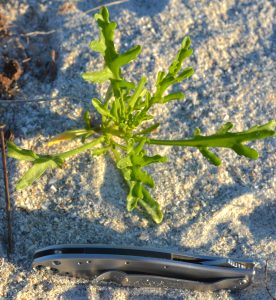
Sea Rocket is just starting its seasonal run. Photo by Green Deane
At last Sunday’s class at Ft. Desoto we saw Sea Rocket starting it season. It was quite young and still mild. We have two species of Cakile or Sea Rocket. They show themselves in our winter and preferably on the beach above the rack line. You can also find them blossoming in coastal dunes. The leaves are a bit fleshy but as they are in a tough environment that helps them preserve water. While Sea Rocket can be found along most coasts of the United States, Maine to Washington State, Florida has its own variety, C. lancelolate. There is a video on them here and you can read more about them here.
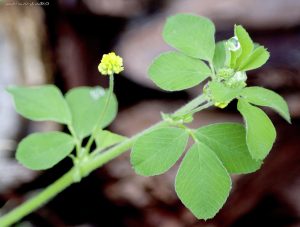
Black Medic is starting it’s seasonal run. Photo by Green Deane
Saw Black Medic for the first time this season. It’s generally considered edible and like many weeds is from Europe. That kind of excludes it from being a significant Native American food (though some sources call it that… It’s a long story.) The headache is that from a distance of about five or six feet (where most people’s eyes are from the ground) Black Medic can look like Hop Clover. Here’s quick way to tell them apart: Hop Clover tends to have red stems, Black Medic has green stems covered with fine white hair and has a longer stem on the center leaf. After the two species go to seed they are easy to sort out: Black Medic has black seeds… hence the name. Hop Clover brown seeds. You can read more about it here.
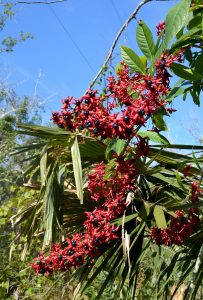
The Glory Bower is not edible but has some relatives that might be. Photo by Green Deane
The Harlequin Glorybower, Clerodendrum Trichotomum, has a very showy calyx. A native of Asia, Clerodendrum means fate tree, referencing questionable medical uses, and trichotomum which means three trunks, which it apparently has often. But it has edible relatives: C. serratum: Young leaves and tops eaten raw as a side dish or roasted briefly and served with a hot pepper sauce. C. paniculatum, the Pagoda Flower, is also listed by some as having edible parts and is a common ornamental locally. I’ve never investigate it.
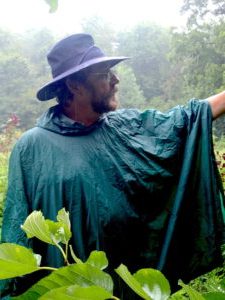
Classes are held rain, shine or cold.
Foraging Classes: One class this weekend, Sunday in Ocala. Then starting next week I’m back to a regular aschedule.
Sunday, January 3rd, Jervey Gantt Recreation Complex, 2390 SE 36th Ave., Ocala, FL, 34471. 9 a.m to noon. Meet at the entrance to the pool, aka Aquatic Fun Center. There is no fee for this class. However, if you want to make a donation afterwards that’s up to you.
Saturday, January 9th, Dreher Park, 1200 Southern Blvd., West Palm Beach, 33405. 9 a.m. to noon. Meet just north of the science center.
Sunday, January 10th, Mead Gardens, 1500 S. Denning Dr., Winter Park, FL 32789. 9 a.m. to noon. The entrance is on the west side off Denning not the east side off Pennsylvania. Some GPS maps are wrong. Meet near the bathrooms.
For more information, to pre-pay or sign up go here.
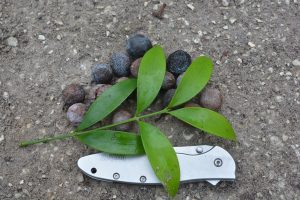
Nagi Trees are very prolific. Photo by Green Deane
The Nagi Tree is odd in that the seed oil is edible but the seed isn’t nor is the fruit. You can boil young leaves but they are kinn of on par with pine needles (which are a distant relative. One odd thing is that the leaves clearly look like a monocot, that is, they don’t have branching veins but all parallel veins and no mid-rib in the leaf. The confusion is there are no monocot trees. These hurricane-proof trees produce piles of pretty blue berries that sprout easily (on their own in fact.) It’s just too bad they are not edible (neither are the blue fruit of the Japanese Blueberry Tree that resembles an olive.) You can read about the Nagi Tree here.
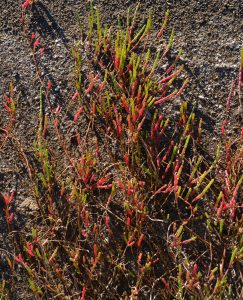
Red Glasswort shows it salty age. Photo by Green Deane
Botany Builder #26: Torose, also torulose: Cylindrical with swelling or contractions at intervals. It comes from the Dead Latin “torus” meaning a bulge or protuberance. Some might immediately think of certain cactus as torose, and some are. But other plants are torose as well, such as Glasswort, Salicornia bigelovii, found growing in salt marshes. We saw a lot of it this past week at Ft. Desoto. When young the plant is green but as the season goes on it sequesters salt in various area which then turn pink. So the green parts can be eaten raw or cooked and the pink parts used when you want a salty flavor. While the plant can be boiled to reduce the salty flavor the greens can also be put in what you’re cooking or flavor it such as a fresh caught fish or harvested squash. To read more about Glasswort go here.

Green Deane videos are now available on a USB.
A 150-video USB or 135 video DVD set would be a good winter present and either is now $99. My nine-DVD set of 135 videos has been selling for seven years and are still available. They are the same videos I have on You Tube. Some people like to have a separate copy. A second option is a16-gig USB that has those 135 videos plus 15 more. While the videos can be run from the DVDs the videos on the USB have to be copied to your computer to play. They are MP4 files. The150-video USB is $99 and the 135-video DVD set is now $99. The DVDs will be sold until they run out then will be exclusively replaced by the USB. This is a change I’ve been trying to make for several years. So if you have been wanting the 135-video DVD set order it now as the price is reduced and the supply limited. Or you can order the USB. My headache is getting my WordPress Order page changed to reflect these changes. We’ve been working on it for several months. However, if you want to order now either the USB or the DVD set make a $99 “donation” using the link at the bottom of this page or here. That order form provides me with your address, the amount — $99 — tells me it is not a donation and in the note say if you want the DVD set or the USB.

Green Deane Forum
Want to identify a plant? Perhaps you’re looking for a foraging reference? You might have a UFO, an Unidentified Flowering Object, you want identified. On the Green Deane Forum we — including Green Deane and others from around the world — chat about foraging all year. And it’s not just about warm-weather plants or just North American flora. Many nations share common weeds so there’s a lot to talk. There’s also more than weeds. The reference section has information for foraging around the world. There are also articles on food preservation, and forgotten skills from making bows to fermenting food.
This is weekly newsletter #438. If you want to subscribe to this free newsletter you can find the sign-up form in the menu at the top of the page.
To donate to the Green Deane Newsletter click here.

